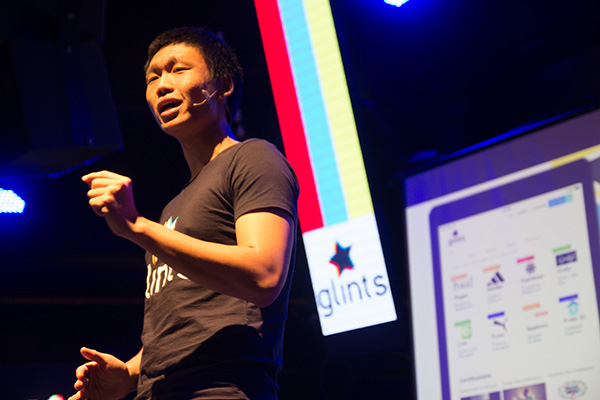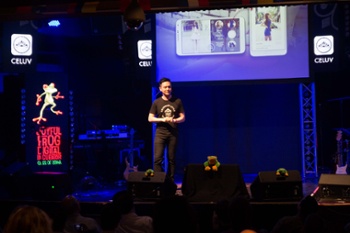Venture capitalists and other investors scour the planet looking for startup diamonds hidden deep in mounds of gravel. Access to these investors is one of the main reasons startups join an accelerator program.
JFDI’s Peter Browne describes how you can polish your startup business and shine at a pitching competition, demo day or in an elevator.

JFDI Demo Day is a ruthless forum where 120 investors from Asia, Europe and America gather for an evening to scrutinise and assess each startup team’s pitch for investment.
In a packed program, the JFDI ‘frogs’ strut and fret their business on the stage in just 6 minutes each, back to back.
Their challenge is to capture and hold the investors’ attention and deliver a coherent, compelling case for investment that demands a meeting to begin the romantic prelude to a potential, profitable partnership.
This is a high stakes game.
One shot.
You have one shot to pitch your startup – not only to excite the investors with your idea – but also so they can mark you down as an entrepreneur worth following.
In my training and experience as a professional actor in Australia, I learnt how to engage an audience and in my work coaching executives and producing corporate videos and events, I help clients communicate complex content with clarity.
At JFDI, my job is to prepare each of the startup teams for Demo Day.

Same same – but different
The current batch of JFDI frogs come from Singapore, Thailand, India, Australia, the Philippines, Poland and America and at the beginning of the 100 day accelerator program, they display a remarkable similarity to all the previous JFDI batches.
They are all passionate but they have a diverse range of pitching competency.
Some pitch with clarity and impact – but their story is unclear;
Some are uncertain in their delivery – struggling to find the right words and phrases;
Some are strongly affected by their nervousness or anxiety – their body telling a different story to their words;
And some are very difficult to understand – either because their content is unclear or because English is not their first language and consequently their content, no matter how strong, is in danger of being lost in translation.
Fortunately – with a 100 day program – there is time to address all these issues.

It all comes down to 5 key skills
I ask the ‘frogs’ to prepare a 1 minute pitch which we use in the 2 hour group sessions.
In these sessions, they learn the 5 key skills that all great presenters employ to engage their audience and they use the 1 minute pitch to practice the skills and receive feedback.
Connection:
Look at your audience – look into their eyes, engage with individuals in each section of the crowd so everyone feels included … tell them your story – talk to them with integrity and passion. This is a hurdle for many people – but with frequent practise, the fear subsides, confidence grows and real communication begins.
Physical presence:
What you look like to the audience is a lasting visual impression. Take control of your body – your movement across the stage, your gestures – importantly, your posture and equally importantly – stillness. You are in control and your physical presence can be engineered to accentuate the key points of your pitch. Again, the trial and error opportunity in the group-practise sessions helps to overcome fear and anxiety – and you learn how to be your own puppet-master.

Expression:
Expression in your voice, your face and your body underlines and reinforces the emphasis that you give to your content. Rhythm and pace, softness and loudness – silence … vigorous and delicate movements and gestures, animated facial expression – all these are tools and levers that add immense contrast and tone to the meaning of your content and hold the audience attention … like signposts along a journey.
Articulation:
If you’re pronunciation is incorrect or your diction is imprecise, and you combine this with furious pace – there is a big risk investors will not understand you and no matter the strength of your pitch – they will be unimpressed by your inability to communicate. We overcome this by educating presenters the correct pronunciation of English vowels and mechanically, how to make strong and correct consonant sounds. These are then applied to words – and we encourage frequent practise to embed change. And the simple act of slowing down and speaking words deliberately and with precision is a strong foundation for change.
Preparation:
There’s an old saying – if you fail to prepare, you prepare to fail. Rehearse your content with team members and/or mentors and make decisions how to deliver every section and every key point of your pitch. Practise until perfect – then practise being perfect every time.
In the weeks before JFDI’s Demo Day, in one-on-one sessions, we rehearse and practise each pitch with regular frequency – allowing the teams to exercise their newly learned skills and develop confidence and authority.
Now – the frogs are confident, calm and seasoned, ready for the slings and arrows of outrageous investors.
Are you currently thinking about founding a startup? Do you have an idea you think is worth pursuing? Do you need some guidance? Discuss your startup with us and find out how JFDI can help!


